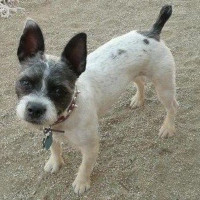Appearance of the Bossi-Poo
|
| Although the Miniature Poodle and the Boston Terrier have similar heights and weights, their facial features and coat types are very different, meaning that their offspring vary in appearance, even within the same litter. With successive matings, this variation will diminish, but for the time being, each Bossi-Poo puppy will have a somewhat distinctive look. The Bossi-Poo's skull is relatively small, and it tends to have a longer muzzle and fewer facial creases than its Boston Terrier relative. While their ears can stand up straight, most will have ears that turn back and fold forward. Their dark brown eyes are almond-shaped, giving them a gentle, curious expression. Their body is lean and compact, while their limbs should be straight and symmetrical. The Bossi-Poo's tail can be short and curly like the Boston Terrier, or long and straight like that of the Poodle. Some individuals will wear a short coat, others a medium-length, wavy or curly coat. Many will be black and white, but the coat can just as easily be brown or gray. Facial fur tends to be a little longer than body fur, and whiskers are not uncommon. White patches on areas such as the chest and legs are common. Adult Bossi-Poos measure from 28 to 38 centimeters and weigh from 6.8 to 11 kilos, bearing in mind that these are the figures from the cross with the Miniature Poodle and that if a standard Poodle were used, the offspring would be considerably larger. |
Temperament of the Bossi-Poo
|
| As both the Poodle and the Boston Terrier are wonderful pets with sparkling personalities and a real eagerness to please, it's not surprising that the Bossi-Poo is an affectionate and passionate animal. Most will be independent and bold, happy in their own company and not overly reliant on their owners. Although they will form close bonds with their families, they will rarely do so to the extent that this becomes a problem, and separation anxiety is not a frequent feature of this breed. Highly sociable and always keen to meet new people and animals, the Bossi-Poo will be friendly and outgoing both inside and outside the home. This means they should have plenty of opportunities to mingle with other dogs, especially at local boarding kennels or dog parks where they're happiest. Their trusting nature and love of all things two- and four-legged make the Bossi-Poo a pretty awful watchdog, and they're more likely to try to befriend an intruder rather than scare them away. |
Needs and activities of the Bossi-Poo
|
| This hybrid breed is good at tricks, competitive obedience, guarding and agility. They are very active and will need regular exercise, but they should be happy to live in any home. A house or apartment with a yard or nothing will suit this breed, but make sure they get their 30 to 60 minutes of activity a day. |
Maintenance of the Bossi-Poo
|
| The Bossi-Poo is very tolerant of heat but not so tolerant of cold, so may need a sweater when walking outdoors in winter. This breed has low shedding levels, but should always be brushed once or twice a week. Like all dogs, the Bossi-Poo will need regular maintenance of its teeth, nails and ears. If possible, brush his teeth every day, and at least two or three times a week. If you hear your pet's nails clicking on the floor, it means they're overdue for grooming. On average, dogs need their nails trimmed once or twice a month, but in some individuals, nails wear naturally and they may need it less often. As many dogs can easily develop ear infections, you should clean them weekly to keep them clean and healthy. Since this breed can sometimes have a foul odor, bathe them from time to time. |









 English (United Kingdom)
English (United Kingdom)